Europe
This article is about the continent. For other uses, see Europe (disambiguation).
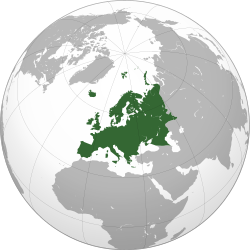 | |
| Area | 10,180,000 km2(3,930,000 sq mi)[n] |
|---|---|
| Population | 739,165,030[n] (2011), 3rd) |
| Pop. density | 72.5/km2 |
| Demonym | European |
| Countries | 50 (list of countries) |
| Languages | List of languages |
| Time Zones | UTC to UTC+6 |
| Internet TLD | .eu (European Union) |
| Largest cities | List of metropolitan areas in Europe |
Europe ( i/ˈjʊərəp/ ewr-əp or /ˈjɜrəp/ yur-əp[1]) is, by convention, one of the world's sevencontinents. Comprising the westernmost peninsula of Eurasia, Europe is generally divided from Asiaby the watershed divides of the Ural and Caucasus Mountains, the Ural River, the Caspian and BlackSeas, and the waterways connecting the Black and Aegean Seas.[2]
i/ˈjʊərəp/ ewr-əp or /ˈjɜrəp/ yur-əp[1]) is, by convention, one of the world's sevencontinents. Comprising the westernmost peninsula of Eurasia, Europe is generally divided from Asiaby the watershed divides of the Ural and Caucasus Mountains, the Ural River, the Caspian and BlackSeas, and the waterways connecting the Black and Aegean Seas.[2]
Europe is bordered by the Arctic Ocean to the north, the Atlantic Ocean to the west, the Mediterranean Sea to the south, and the Black Sea and connected waterways to the southeast. Yet the borders of Europe—a concept dating back to classical antiquity—are somewhat arbitrary, as the primarilyphysiographic term "continent" can incorporate cultural and political elements.
Europe is the world's second-smallest continent by surface area, covering about 10,180,000 square kilometres (3,930,000 sq mi) or 2% of the Earth's surface and about 6.8% of its land area. Of Europe's approximately 50 states, Russia is by far the largest by both area and population, taking up 40% of the continent (although the country has territory in both Europe and Asia), while Vatican City is the smallest. Europe is the third-most populous continent after Asia and Africa, with a population of 733 million or about 11% of the world's population.[3]
Europe, in particular Ancient Greece, is the birthplace of Western culture.[4] It played a predominant role in global affairs from the 15th century onwards, especially after the beginning of colonialism. Between the 16th and 20th centuries, European nations controlled at various times the Americas,most of Africa, Oceania, and large portions of Asia. In 1900, Europe's share of the world's population was 25%.[5]
Both World Wars were largely focused upon Europe, greatly contributing to a decline in Western European dominance in world affairs by the mid-20th century as the United States and Soviet Uniontook prominence.[6] During the Cold War, Europe was divided along the Iron Curtain between NATO in the west and the Warsaw Pact in the east. European integration led to the formation of the Council of Europe and the European Union in Western Europe, both of which have been expanding eastward since the revolutions of 1989 and the fall of the Soviet Union in 1991.
Further information: List of countries spanning more than one continent
Definition
Further information: Borders of the continents
The use of the term "Europe" has developed gradually throughout history.[7][8] In antiquity, the Greek historian Herodotus mentioned that the world had been divided by unknown persons into three parts, Europe, Asia, and Libya (Africa), with the Nile and the River Phasis forming their boundaries—though he also states that some considered the River Don, rather than the Phasis, as the boundary between Europe and Asia.[9]Europe's eastern frontier was defined in the 1st century by geographerStrabo at the River Don.[10] Flavius and the Book of Jubilees described the continents as the lands given by Noah to his three sons; Europe was defined as stretching from the Pillars of Hercules at the Strait of Gibraltar, separating it from North Africa, to the Don, separating it from Asia.[11]
A cultural definition of Europe as the lands of Latin Christendom coalesced in the 8th century, signifying the new cultural condominium created through the confluence of Germanic traditions and Christian-Latin culture, defined partly in contrast with Byzantium and Islam, and limited to northern Iberia, the British Isles, France, Christianized western Germany, the Alpine regions and northern and central Italy.[12] The concept is one of the lasting legacies of the Carolingian Renaissance: "Europa" often figures in the letters of Charlemagne's cultural minister, Alcuin.[13] This division—as much cultural as geographical—was used until theLate Middle Ages, when it was challenged by the Age of Discovery.[14][15][why?] The problem of redefining Europe was finally resolved in 1730 when, instead of waterways, the Swedish geographer and cartographer von Strahlenbergproposed the Ural Mountains as the most significant eastern boundary, a suggestion that found favour in Russia and throughout Europe.[16]
Europe is now generally defined by geographers as the westernmost peninsula of Eurasia, with its boundaries marked by large bodies of water to the north, west and south; Europe's limits to the far east are usually taken to be the Urals, the Ural River, and the Caspian Sea; to the south-east, including the Caucasus Mountains, the Black Sea and the waterways connecting the Black Sea to the Mediterranean Sea.[17] Because of sociopolitical and cultural differences, there are various descriptions of Europe's boundary. For example, Cyprus is approximate to Anatolia (or Asia Minor), but is usually considered part of Europe both culturally and politically and currently is a member state of the EU. In addition, Malta was considered an island of North Africa for centuries,[18] while Iceland, though nearer toGreenland (North America), is also generally included in Europe.
Sometimes, the word 'Europe' is used in a geopolitically limiting way[19] to refer only to the European Union or, even more exclusively, a culturally defined core. On the other hand, the Council of Europe has 47 member countries, and only 27 member states are in the EU.[20] In addition, people living in areas such as Ireland, the United Kingdom, the North Atlantic and Mediterranean islands and also in Scandinavia may routinely refer to"continental" or "mainland" Europe simply as Europe or "the Continent".[21]
Etymology
In ancient Greek mythology, Europa was a Phoenician princess whom Zeus abducted after assuming the form of a dazzling white bull. He took her to the island of Crete where she gave birth to Minos,Rhadamanthus, and Sarpedon. For Homer, Europe (Ancient Greek: Εὐρώπη, Eurṓpē; see also List of Greek place names) was a mythological queen of Crete, not a geographical designation.
The etymology of Europa is uncertain.[24] One theory suggests that it is derived from the Greek εὐρύς (eurus), meaning "wide, broad"[25] and ὤψ/ὠπ-/ὀπτ- (ōps/ōp-/opt-), meaning "eye, face, countenance",[26]hence Eurṓpē, "wide-gazing", "broad of aspect" (compare with glaukōpis (γλαυκῶπις 'grey-eyed') Athena orboōpis (βοὠπις 'ox-eyed') Hera). Broad has been an epithet of Earth itself in the reconstructed Proto-Indo-European religion.[27] Another theory suggests that it is based on a Semitic word such as the Akkadianerebu meaning "to go down, set" (cf. Occident),[28] cognate to Phoenician 'ereb "evening; west" and ArabicMaghreb, Hebrew ma'ariv (see also Erebus, PIE *h1regʷos, "darkness"). However, Martin Litchfield Weststates that "phonologically, the match between Europa's name and any form of the Semitic word is very poor".[29]
Whatever the origin of the name of the mythological figure, Εὐρώπη is first used as a geographical term in the 6th century BC, by Greek geographers such as Anaximander and Hecataeus. Anaximander placed the boundary between Asia and Europe along the Phasis River (the modern Rioni) in the Caucasus, a convention still followed by Herodotus in the 5th century BC.[30] But the convention received by the Middle Ages and surviving into modern usage is that of the Roman era used by Roman era authors such as Posidonius,[31] Strabo[32] and Ptolemy,[33] who took the Tanais (the modern Don River) as the boundary. The term "Europe" is first used for a cultural sphere in the Carolingian Renaissance of the 9th century. From that time, the term designated the sphere of influence of the Western Church, as opposed to both the Eastern Orthodox churches and to the Islamic world. The modern convention, enlarging the area of "Europe" somewhat to the east and the south-east, develops in the 19th century.
Most major world languages use words derived from "Europa" to refer to the "continent" (peninsula). Chinese, for example, uses the word Ōuzhōu(歐洲); a similar Chinese-derived term Ōshū (欧州) is also sometimes used in Japanese such as in the Japanese name of the European Union,Ōshū Rengō (欧州連合), despite the katakana Yōroppa (ヨーロッパ) being more commonly used. However, in some Turkic languages the originally Persian name Frangistan (land of the Franks) is used casually in referring to much of Europe, besides official names such as Avrupa orEvropa.[34]
History
Main article: History of Europe
Prehistory
Main article: Prehistoric Europe
Homo georgicus, which lived roughly 1.8 million years ago in Georgia, is the earliest hominid to have been discovered in Europe.[35] Other hominid remains, dating back roughly 1 million years, have been discovered in Atapuerca, Spain.[36] Neanderthal man (named after the Neandertalvalley in Germany) appeared in Europe 150,000 years ago and disappeared from the fossil record about 28,000 BC, with this extinction probably due to climate change, and their final refuge being present-day Portugal. The Neanderthals were supplanted by modern humans (Cro-Magnons), who appeared in Europe around 43 to 40 thousand years ago.[37]
The European Neolithic period—marked by the cultivation of crops and the raising of livestock, increased numbers of settlements and the widespread use of pottery—began around 7000 BC in Greece and the Balkans, probably influenced by earlier farming practices in Anatolia and theNear East. It spread from the Balkans along the valleys of the Danube and the Rhine (Linear Pottery culture) and along the Mediterranean coast (Cardial culture). Between 4500 and 3000 BC, these central European neolithic cultures developed further to the west and the north, transmitting newly acquired skills in producing copper artefacts. In Western Europe the Neolithic period was characterized not by large agricultural settlements but by field monuments, such ascausewayed enclosures, burial mounds and megalithic tombs.[38] The Corded Ware cultural horizon flourished at the transition from the Neolithic to the Chalcolithic. During this period giantmegalithic monuments, such as the Megalithic Temples of Malta and Stonehenge, were constructed throughout Western and Southern Europe.[39][40] The European Bronze Age began circa 3200 BC in Greece.[41]
The European Iron Age began around 1200 BC.[42] Iron Age colonisation by the Greeks and Phoenicians gave rise to earlyMediterranean cities. Early Iron Age Italy and Greece from around the 8th century BC gradually gave rise to historical Classical antiquity.
Classical antiquity
Main article: Classical antiquity
See also: Ancient Greece and Ancient Rome
Ancient Greece had a profound influence on Western civilisation. Western democratic and individualistic culture are often attributed to Ancient Greece.[43] The Greeks invented the polis, or city-state, which played a fundamental role in their concept of identity.[44] These Greek political ideals were rediscovered in the late 18th century by European philosophers and idealists. Greece also generated many cultural contributions: in philosophy, humanism and rationalism under Aristotle, Socrates and Plato; in history with Herodotusand Thucydides; in dramatic and narrative verse, starting with the epic poems of Homer;[43] in medicine with Hippocrates and Galen; and in science with Pythagoras, Euclid and Archimedes.[45][46][47]
Another major influence came on Europe that would impact Western civilisation from the Roman Empire which left its mark on law, politics, language, engineering, architecture, governmentand many more aspects in western civilization.[48] During the pax romana, the Roman Empire expanded to encompass the entireMediterranean Basin and much of Europe.[49]
Stoicism influenced Roman emperors such as Hadrian, Antoninus Pius, and Marcus Aurelius, who all spent time on the Empire's northern border fighting Germanic, Pictish and Scottish tribes.[50][51]Christianity was eventually legitimised by Constantine I after three centuries of imperial persecution.
Early Middle Ages
Main articles: Late Antiquity and Early Middle Ages
See also: Dark Ages (historiography) and Age of Migrations
During the decline of the Roman Empire, Europe entered a long period of change arising from what historians call the "Age of Migrations". There were numerous invasions and migrations amongst theOstrogoths, Visigoths, Goths, Vandals, Huns, Franks, Angles, Saxons, Slavs, Avars, Bulgars and, later still, the Vikings and Magyars.[49] Renaissance thinkers such as Petrarch would later refer to this as the "Dark Ages".[52] Isolated monastic communities were the only places to safeguard and compile written knowledge accumulated previously; apart from this very few written records survive and much literature, philosophy, mathematics, and other thinking from the classical period disappeared from Europe.[53]
From the 7th century Byzantine history was greatly affected by the rise of Islam and the Caliphates. MuslimArabs first invaded historically Roman territory under Abū Bakr, first Caliph of the Rashidun Caliphate, who entered Roman Syria and Roman Mesopotamia. Under Umar, the second Caliph, the Muslims decisively conquered Syria and Mesopotamia, as well as Roman Palestine, Roman Egypt, and parts of Asia Minorand Roman North Africa. This trend continued under Umar's successors and under the Umayyad Caliphate, which conquered the rest of Mediterranean North Africa and most of the Iberian Peninsula. Over the next centuries Muslim forces were able to take further European territory, including Cyprus, Malta,Crete, Sicily and parts of southern Italy.[54] In the East, Volga Bulgaria became an Islamic state in the tenth century.[55]
The Muslim conquest of Hispania began when the Moors (mostly Berbers with someArabs) invaded the Christian Visigothic kingdom of Iberia in the year 711, under their Berber leader Tariq ibn Ziyad. They landed at Gibraltar on 30 April and worked their way northward. Tariq's forces were joined the next year by those of his superior, Musa ibn Nusair. During the eight-year campaign most of the Iberian Peninsula was brought under Muslim rule — save for small areas in the northwest (Asturias) and largely Basque regions in the Pyrenees, with the exception of the Basque Banu QasiMuslim dynasty. This territory, under the Arabic name Al-Andalus, became part of the expanding Umayyad empire.
The unsuccessful second siege of Constantinople (717) weakened the Umayyad dynasty and reduced their prestige. After their success in overrunning Iberia, the conquerors moved northeast across the Pyrenees, but were defeated by the Frankishleader Charles Martel at the Battle of Poitiers in 732, though they continued to raid and capture cities as far as Avignon. The Umayyads were overthrown in 750 by the 'Abbāsids and most of the Umayyad clan massacred.
A surviving Umayyad prince, Abd-ar-rahman I, escaped to Iberia and founded a new Umayyad dynasty in the Emirate of Cordoba, (756). Charles Martel's son, Pippin the Short retook Narbonne, and his grandson Charlemagne established the Marca Hispanica across the Pyrenees in part of what today is Catalonia, reconquering Girona in 785 and Barcelona in 801. The Umayyads in Iberia proclaimed themselves caliphs in 929.
During the Dark Ages, the Western Roman Empire fell under the control of various tribes. The Germanic and Slav tribes established their domains over Western and Eastern Europe respectively.[56] Eventually the Frankish tribes were united under Clovis I.[57] Charlemagne, a Frankish king of theCarolingian dynasty who had conquered most of Western Europe, was anointed "Holy Roman Emperor" by the Pope in 800. This led to the founding of the Holy Roman Empire, which eventually became centred in the German principalities of central Europe.[58]
The predominantly Greek speaking Eastern Roman Empire became known in the West as the Byzantine Empire. Its capital was Constantinople. Emperor Justinian I presided over Constantinople's first golden age: he established a legal code, funded the construction of the Hagia Sophia and brought the Christian church under state control.[59] Fatally weakened by the sack of Constantinople in 1204, during the Fourth Crusade,[60][61][62][63][64][65][66][67][68] Byzantium fell in 1453 when it was conquered by the Ottoman Empire.[69][70][71]
Middle Ages
See also: Medieval demography
The economic growth of Europe around the year 1000, together with the lack of safety on the mainland trading routes, made possible the development of major commercial routes along the coast of the Mediterranean Sea. In this context, the growing independence acquired by some coastal cities gave the Maritime Republics a leading role in the European scene.
The Middle Ages on the mainland were dominated by the two upper echelons of the social structure: the nobility and the clergy. Feudalism developed in France in the Early Middle Ages and soon spread throughout Europe.[72] A struggle for influence between the nobility and the monarchy in England led to the writing of the Magna Carta and the establishment of a parliament.[73] The primary source of culture in this period came from the Roman Catholic Church. Through monasteries and cathedral schools, the Church was responsible for education in much of Europe.[72]
The Papacy reached the height of its power during the High Middle Ages. An East-West Schism in 1054 split the former Roman Empire religiously, with the Eastern Orthodox Church in the Byzantine Empire and the Roman Catholic Church in the former Western Roman Empire. In 1095 Pope Urban II called for acrusade against Muslims occupying Jerusalem and the Holy Land.[74] In Europe itself, the Church organised the Inquisition against heretics. In Spain, the Reconquista concluded with the fall of Granada in 1492, ending over seven centuries of Islamic rule in the Iberian Peninsula.[75]
In the 11th and 12th centuries, constant incursions by nomadic Turkictribes, such as the Pechenegs and the Cuman-Kipchaks, caused a massive migration of Slavic populations to the safer, heavily forested regions of the north and temporarily halted the expansion of the Rus' state to the south and east.[76] Like many other parts of Eurasia, these territories were overrun by the Mongols.[77] The invaders, who became known as Tatars, were mostly Turkic under Mongol command. They established the state of the Golden Horde, which later adopted Islam as a religion and ruled over modern-day southern and central Russia and Ukraine for more than three centuries.[78][79]
The Great Famine of 1315–1317 was the first crisis that would strike Europe in the late Middle Ages.[80] The period between 1348 and 1420 witnessed the heaviest loss. The population of France was reduced by half.[81][82] Medieval Britain was afflicted by 95 famines,[83] and France suffered the effects of 75 or more in the same period.[84] Europe was devastated in the mid-14th century by the Black Death, one of the most deadly pandemics in human history which killed an estimated 25 million people in Europe alone—a third of the European population at the time.[85]
The plague had a devastating effect on Europe's social structure; it induced people to live for the moment as illustrated by Giovanni Boccaccio in The Decameron (1353). It was a serious blow to the Roman Catholic Church and led to increased persecution of Jews, foreigners, beggars and lepers.[86] The plague is thought to have returned every generation with varying virulence and mortalities until the 18th century.[87] During this period, more than 100 plague epidemics swept across Europe.[88]
Early modern period
Main article: Early modern period
The Renaissance was a period of cultural change originating in Florence and later spreading to the rest of Europe. in the 14th century. The rise of a new humanism was accompanied by the recovery of forgottenclassical Greek and Arabic knowledge from monastic libraries, often re-translated from Arabic intoLatin.[89][90][91] The Renaissance spread across Europe between the 14th and 16th centuries: it saw the flowering of art, philosophy, music, and the sciences, under the joint patronage of royalty, the nobility, theRoman Catholic Church, and an emerging merchant class.[92][93][94] Patrons in Italy, including the Medicifamily of Florentine bankers and the Popes in Rome, funded prolific quattrocento and cinquecento artists such as Raphael, Michelangelo, and Leonardo da Vinci.[95][96]
Political intrigue within the Church in the mid-14th century caused the Great Schism. During this forty-year period, two popes—one in Avignon and one in Rome—claimed rulership over the Church. Although the schism was eventually healed in 1417, the papacy's spiritual authority had suffered greatly.[97]
The Church's power was further weakened by the Protestant Reformation (1517–1648), initially sparked by the works of German theologian Martin Luther, a result of the lack of reform within the Church. The Reformation also damaged the Holy Roman Empire's power, as German princes became divided between Protestant and Roman Catholic faiths.[98] This eventually led to the Thirty Years War (1618–1648), which crippled the Holy Roman Empire and devastated much of Germany, killing between 25 and 40 percent of its population.[99] In the aftermath of the Peace of Westphalia, France rose to predominance within Europe.[100] The 17th century in southern and eastern Europe was a period of general decline.[101]Eastern Europe experienced more than 150 famines in a 200-year period between 1501 to 1700.[102] In the 15th–18th centuries, when the disintegrating khanates of the Golden Horde were conquered by Russia, Tatars from the Crimean Khanate frequently raided Eastern Slavic lands to capture slaves.[103]
The Renaissance and the New Monarchs marked the start of an Age of Discovery, a period of exploration, invention, and scientific development.[104] Among the great figures of the Western scientific revolution of the 16th and 17th centuries were Copernicus, Kepler, Galileo, and Isaac Newton.[105] According to Peter Barrett, "It is widely accepted that 'modern science' arose in the Europe of the 17th century (towards the end of the Renaissance), introducing a new understanding of the natural world."[89] In the 15th century, Portugal and Spain, two of the greatest naval powers of the time, took the lead in exploring the world.[106][107] Christopher Columbus reached the New World in 1492, and soon after the Spanish and Portuguese began establishing colonial empires in the Americas.[108] France, the Netherlands and England soon followed in building large colonial empires with vast holdings in Africa, the Americas, and Asia.
18th and 19th centuries
Main article: Modern history
The Age of Enlightenment was a powerful intellectual movement during the 18th century promoting scientific and reason-based thoughts.[109][110][111] Discontent with the aristocracy and clergy's monopoly on political power in France resulted in the French Revolution and the establishment of the First Republicas a result of which the monarchy and many of the nobility perished during the initial reign of terror.[112]Napoleon Bonaparte rose to power in the aftermath of the French Revolution and established the First French Empire that, during the Napoleonic Wars, grew to encompass large parts of Europe before collapsing in 1815 with the Battle of Waterloo.[113][114]
Napoleonic rule resulted in the further dissemination of the ideals of the French Revolution, including that of the nation-state, as well as the widespread adoption of the French models of administration, law, andeducation.[115][116][117] The Congress of Vienna, convened after Napoleon's downfall, established a newbalance of power in Europe centred on the five "Great Powers": the United Kingdom, France, Prussia, Habsburg Austria, and Russia.[118]
This balance would remain in place until the Revolutions of 1848, during which liberal uprisings affected all of Europe except for Russia and the United Kingdom. These revolutions were eventually put down by conservative elements and few reforms resulted.[119] In 1867, the Austro-Hungarian empire was formed; and 1871 saw the unifications of both Italy and Germany as nation-states from smaller principalities.[120]Likewise, in 1878 the Congress of Berlin has conveyed formal recognition to the de facto independent principalities of Montenegro, Serbia and Romania.
The Industrial Revolution started in Great Britain in the last part of the 18th century and spread throughout Europe. The invention and implementation of new technologies resulted in rapid urban growth, mass employment, and the rise of a new working class.[121] Reforms in social and economic spheres followed, including the first laws on child labour, the legalisation of trade unions,[122] and the abolition of slavery.[123] In Britain, the Public Health Act 1875 was passed, which significantly improved living conditions in many British cities.[124] Europe's population increased from about 100 million in 1700 to 400 million by 1900.[125] In the 19th century, 70 million people left Europe in migrations to various European colonies abroad and to the United States.[126]
20th century to present
Main articles: Modern era and History of Europe
See also: World War I, Great Depression, Interwar period, World War II, Cold War, and History of the European Union
Two World Wars and an economic depression dominated the first half of the 20th century. World War I was fought between 1914 and 1918. It started when Archduke Franz Ferdinand of Austria was assassinated by the Bosnian Serb Gavrilo Princip.[127] Most European nations were drawn into the war, which was fought between the Entente Powers (France, Belgium, Serbia, Portugal, Russia, the United Kingdom, and laterItaly, Greece, Romania, and the United States) and the Central Powers (Austria-Hungary, Germany,Bulgaria, and the Ottoman Empire). The War left more than 16 million civilians and military dead.[128] Over 60 million European soldiers were mobilised from 1914 to 1918.[129]
Partly as a result of its defeat Russia was plunged into the Russian Revolution, which threw down theTsarist monarchy and replaced it with the communist Soviet Union.[130] Austria-Hungary and the Ottoman Empire collapsed and broke up into separate nations, and many other nations had their borders redrawn. The Treaty of Versailles, which officially ended World War I in 1919, was harsh towards Germany, upon whom it placed full responsibility for the war and imposed heavy sanctions.[131]
Economic instability, caused in part by debts incurred in the First World War and 'loans' to Germany played havoc in Europe in the late 1920s and 1930s. This and the Wall Street Crash of 1929 brought about the worldwide Great Depression. Helped by the economic crisis, social instability and the threat of communism,fascist movements developed throughout Europe placing Adolf Hitler of Nazi Germany, Francisco Franco of Spain and Benito Mussolini of Italy in power.[132][133]
In 1933, Hitler became the leader of Germany and began to work towards his goal of building Greater Germany. Germany re-expanded and took back the Saarland and Rhineland in 1935 and 1936. In 1938,Austria became a part of Germany following the Anschluss. Later that year, following the Munich Agreement, Germany annexed the Sudetenland, which was a part of Czechoslovakia inhabited by ethnic Germans. At the time, Britain and France preferred a policy of appeasement.
Shortly afterwards, Poland and Hungary started to press for the annexation of parts of Czechoslovakia with Polish and Hungarian majorities. Hitler encouraged the Slovaks to do the same and in early 1939, the remainder of Czechoslovakia was split into the Protectorate of Bohemia and Moravia, controlled by Germany, and the Slovak Republic, while other smaller regions went to Poland and Hungary. With tensions mounting between Germany and Poland over the future of Danzig, the Germans turned to the Soviets, and signed theMolotov–Ribbentrop Pact. Germany invaded Poland on 1 September 1939, prompting France and the United Kingdom to declare war on Germany on 3 September, opening the European Theatre of World War II.[134][135]The Soviet invasion of Poland started on 17 September and Poland fell soon thereafter.
On 24 September, the Soviet Union attacked the Baltic countries and later, Finland. The British hoped to land at Narvik and send troops to aid Finland, but their primary objective in the landing was to encircle Germany and cut the Germans off from Scandinavian resources. Nevertheless, the Germans knew of Britain's plans and got to Narvik first, repulsing the attack. Around the same time, Germany moved troops into Denmark, which left no room for a front except for where the last war had been fought or by landing at sea. The Phoney War continued.
In May 1940, Germany attacked France through the Low Countries. France capitulated in June 1940. However, the British refused to negotiate peace terms with the Germans and the war continued. By August Germany began a bombing offensive on Britain, but failed to convince the Britons to give up.[136] In 1941, Germany invaded the Soviet Union in the ultimately unsuccessful Operation Barbarossa.[137] On 7 December 1941 Japan's attack on Pearl Harbor drew the United States into the conflict as allies of the British Empire and other allied forces.[138][139]
After the staggering Battle of Stalingrad in 1943, the German offensive in the Soviet Union turned into a continual fallback. In 1944, British and American forces invaded France in the D-Day landings, opening a new front against Germany. Berlin finally fell in 1945, ending World War II in Europe. The war was the largest and most destructive in human history, with 60 million dead across the world.[140] More than 40 million people in Europe had died as a result of the war by the time World War II ended,[141] including between 11 and 17 million people who perished during the Holocaust.[142] The Soviet Union lost around 27 million people during the war, about half of all World War II casualties.[143] By the end of World War II, Europe had more than 40 million refugees.[144] Several post-war expulsions in Central and Eastern Europe displaced a total of about 20 million people.[145]
World War I and especially World War II diminished the eminence of Western Europe in world affairs. After World War II the map of Europe was redrawn at the Yalta Conference and divided into two blocs, the Western countries and the communist Eastern bloc, separated by what was later called by Winston Churchill an "Iron Curtain". The United States and Western Europe established theNATO alliance and later the Soviet Union and Eastern Europe established the Warsaw Pact.[146]
The two new superpowers, the United States and the Soviet Union, became locked in a fifty-year long Cold War, centred on nuclear proliferation. At the same time decolonisation, which had already started after World War I, gradually resulted in the independence of most of the European colonies in Asia and Africa.[6]In the 1980s the reforms of Mikhail Gorbachev and the Solidarity movement in Poland accelerated the collapse of the Eastern bloc and the end of the Cold War. Germany was reunited, after the symbolic fall of the Berlin Wall in 1989, and the maps of Eastern Europe were redrawn once more.[132]
European integration also grew after World War II. The Treaty of Rome in 1957 established the European Economic Community between six Western European states with the goal of a unified economic policy and common market.[147] In 1967 the EEC,European Coal and Steel Community and Euratom formed the European Community, which in 1993 became the European Union. The EU established a parliament, court and central bank and introduced the euro as a unified currency.[148] In 2004 and 2007, more Eastern European countries began joining, expanding the EU to its current size of 27 European countries, and once more making Europe a major economical and political centre of power.[149]
|
Geography
Main article: Geography of Europe
Europe is a peninsula that makes up the western fifth of the Eurasian landmass.[17] Its maritime borders are made up of the Arctic Ocean to the north, the Atlantic Ocean to the west, and the Mediterranean, Black, and Caspian Seas to the south[150] Land relief in Europe shows great variation within relatively small areas. The southern regions are more mountainous, while moving north the terrain descends from the high Alps, Pyrenees, and Carpathians, through hilly uplands, into broad, low northern plains, which are vast in the east. This extended lowland is known as the Great European Plain, and at its heart lies theNorth German Plain. An arc of uplands also exists along the north-western seaboard, which begins in the western parts of the islands of Britain and Ireland, and then continues along the mountainous, fjord-cut spine of Norway.
This description is simplified. Sub-regions such as the Iberian Peninsula and the Italian Peninsula contain their own complex features, as does mainland Central Europe itself, where the relief contains many plateaus, river valleys and basins that complicate the general trend. Sub-regions like Iceland, Britain, and Ireland are special cases. The former is a land unto itself in the northern ocean which is counted as part of Europe, while the latter are upland areas that were once joined to the mainland until rising sea levels cut them off.
Climate
Main article: Climate of Europe
Europe lies mainly in the temperate climate zones, being subjected to prevailing westerlies.
The climate is milder in comparison to other areas of the same latitude around the globe due to the influence of the Gulf Stream.[151] The Gulf Stream is nicknamed "Europe's central heating", because it makes Europe's climate warmer and wetter than it would otherwise be. The Gulf Stream not only carries warm water to Europe's coast but also warms up the prevailing westerly winds that blow across the continent from the Atlantic Ocean.
Therefore the average temperature throughout the year of Naples is 16 °C (60.8 °F), while it is only 12 °C (53.6 °F) in New York City which is almost on the same latitude. Berlin, Germany; Calgary, Canada; and Irkutsk, in the Asian part of Russia, lie on around the same latitude; January temperatures in Berlin average around 8 °C (15 °F) higher than those in Calgary, and they are almost 22 °C (40 °F) higher than average temperatures in Irkutsk.[151]
Geology
Main article: Geology of Europe
The Geology of Europe is hugely varied and complex, and gives rise to the wide variety of landscapes found across the continent, from the Scottish Highlands to the rolling plains of Hungary.[152]
Europe's most significant feature is the dichotomy between highland and mountainous Southern Europe and a vast, partially underwater, northern plain ranging from Ireland in the west to the Ural Mountains in the east. These two halves are separated by the mountain chains of the Pyreneesand Alps/Carpathians. The northern plains are delimited in the west by the Scandinavian Mountains and the mountainous parts of the British Isles. Major shallow water bodies submerging parts of the northern plains are the Celtic Sea, the North Sea, the Baltic Sea complex and Barents Sea.
The northern plain contains the old geological continent of Baltica, and so may be regarded geologically as the "main continent", while peripheral highlands and mountainous regions in the south and west constitute fragments from various other geological continents. Most of the older geology of western Europe existed as part of the ancient microcontinent Avalonia.
Geological history
Main article: Geological history of Europe
The geological history of Europe traces back to the formation of the Baltic Shield (Fennoscandia) and the Sarmatian craton, both around 2.25 billion years ago, followed by the Volgo-Uralia shield, the three together leading to the East European craton (≈ Baltica) which became a part of thesupercontinent Columbia. Around 1.1 billion years ago, Baltica and Arctica (as part of the Laurentia block) became joined to Rodinia, later resplitting around 550 million years ago to reform as Baltica. Around 440 million years ago Euramerica was formed from Baltica and Laurentia; a further joining with Gondwana then leading to the formation of Pangea. Around 190 million years ago, Gondwana and Laurasia split apart due to the widening of the Atlantic Ocean. Finally, and very soon afterwards, Laurasia itself split up again, into Laurentia (North America) and the Eurasian continent. The land connection between the two persisted for a considerable time, via Greenland, leading to interchange of animal species. From around 50 million years ago, rising and falling sea levels have determined the actual shape of Europe, and its connections with continents such as Asia. Europe's present shape dates to the late Tertiary period about five million years ago.[153]
Biodiversity
See also: Fauna of Europe
Having lived side-by-side with agricultural peoples for millennia, Europe's animals and plants have been profoundly affected by the presence and activities of man. With the exception ofFennoscandia and northern Russia, few areas of untouched wilderness are currently found in Europe, except for various national parks.
The main natural vegetation cover in Europe is mixed forest. The conditions for growth are very favourable. In the north, the Gulf Stream and North Atlantic Drift warm the continent. Southern Europe could be described as having a warm, but mild climate. There are frequent summer droughts in this region. Mountain ridges also affect the conditions. Some of these (Alps, Pyrenees) are oriented east-west and allow the wind to carry large masses of water from the ocean in the interior. Others are oriented south-north (Scandinavian Mountains,Dinarides, Carpathians, Apennines) and because the rain falls primarily on the side of mountains that is oriented towards the sea, forests grow well on this side, while on the other side, the conditions are much less favourable. Few corners of mainland Europe have not been grazed by livestock at some point in time, and the cutting down of the pre-agricultural forest habitat caused disruption to the original plant and animal ecosystems.
Probably 80 to 90 per cent of Europe was once covered by forest.[154] It stretched from the Mediterranean Sea to the Arctic Ocean. Though over half of Europe's original forests disappeared through the centuries of deforestation, Europe still has over one quarter of its land area as forest, such as the taiga of Scandinavia and Russia, mixed rainforests of the Caucasus and the Cork oak forests in the western Mediterranean. During recent times, deforestation has been slowed and many trees have been planted. However, in many cases monoculture plantations of conifers have replaced the original mixed natural forest, because these grow quicker. The plantations now cover vast areas of land, but offer poorer habitats for many European forest dwelling species which require a mixture of tree species and diverse forest structure. The amount of natural forest in Western Europe is just 2–3% or less, in European Russia 5–10%. The country with the smallest percentage of forested area is Iceland (1%), while the most forested country is Finland (77%).[155]
In temperate Europe, mixed forest with both broadleaf and coniferous trees dominate. The most important species in central and western Europe are beech and oak. In the north, the taiga is a mixed spruce–pine–birch forest; further north within Russia and extreme northern Scandinavia, the taiga gives way to tundra as the Arctic is approached. In the Mediterranean, many olive trees have been planted, which are very well adapted to its arid climate;Mediterranean Cypress is also widely planted in southern Europe. The semi-arid Mediterranean region hosts much scrub forest. A narrow east-west tongue of Eurasiangrassland (the steppe) extends eastwards from Ukraine and southern Russia and ends in Hungary and traverses into taiga to the north.
Glaciation during the most recent ice age and the presence of man affected the distribution ofEuropean fauna. As for the animals, in many parts of Europe most large animals and toppredator species have been hunted to extinction. The woolly mammoth was extinct before the end of the Neolithic period. Today wolves (carnivores) and bears (omnivores) are endangered. Once they were found in most parts of Europe. However, deforestation and hunting caused these animals to withdraw further and further. By the Middle Ages the bears' habitats were limited to more or less inaccessible mountains with sufficient forest cover. Today, the brown bear lives primarily in the Balkan peninsula, Scandinavia, and Russia; a small number also persist in other countries across Europe (Austria, Pyrenees etc.), but in these areas brown bear populations are fragmented and marginalised because of the destruction of their habitat. In addition, polar bears may be found on Svalbard, a Norwegian archipelago far north of Scandinavia. The wolf, the second largest predator in Europe after the brown bear, can be found primarily in Eastern Europe and in the Balkans, with a handful of packs in pockets of Western Europe (Scandinavia, Spain, etc.).
European wild cat, foxes (especially the red fox), jackal and different species of martens, hedgehogs, different species of reptiles (like snakes such as vipers and grass snakes) and amphibians, different birds (owls, hawks and other birds of prey).
Important European herbivores are snails, larvae, fish, different birds, and mammals, like rodents, deer and roe deer, boars, and living in the mountains, marmots, steinbocks, chamois among others.
The extinction of the dwarf hippos and dwarf elephants has been linked to the earliest arrival of humans on the islands of the Mediterranean.
Sea creatures are also an important part of European flora and fauna. The sea flora is mainlyphytoplankton. Important animals that live in European seas are zooplankton, molluscs, echinoderms, different crustaceans, squids and octopuses, fish, dolphins, and whales.
Biodiversity is protected in Europe through the Council of Europe's Bern Convention, which has also been signed by the European Community as well as non-European states.
Political geography
Main article: Politics of Europe
The list below includes all entities falling even partially under any of the various common definitions of Europe, geographic or political. The data displayed are per sources in cross-referenced articles. The 27 European Union member states are highly integrated, economically and politically; the European Union itself forms part of the political geography of Europe.
| Flag | Arms | Name | Area (km²) | Population | Population density (per km²) | Capital |
|---|---|---|---|---|---|---|
| Albania | 28,748 | 2,831,741 | 98.5 | Tirana | ||
| Andorra | 468 | 68,403 | 146.2 | Andorra la Vella | ||
| Armenia [j] | 29,800 | 3,229,900 | 101 | Yerevan | ||
| Austria | 83,858 | 8,169,929 | 97.4 | Vienna | ||
| N/A | Azerbaijan [k] | 86,600 | 9,165,000 | 105.8 | Baku | |
| Belarus | 207,560 | 9,458,000 | 45.6 | Minsk | ||
| Belgium | 30,528 | 11,007,000 | 360.6 | Brussels | ||
| Bosnia and Herzegovina | 51,129 | 3,843,126 | 75.2 | Sarajevo | ||
| Bulgaria | 110,910 | 7,621,337 | 68.7 | Sofia | ||
| Croatia | 56,542 | 4,437,460 | 77.7 | Zagreb | ||
| Cyprus [d] | 9,251 | 788,457 | 85 | Nicosia | ||
| Czech Republic | 78,866 | 10,256,760 | 130.1 | Prague | ||
| Denmark | 43,094 | 5,564,219 | 129 | Copenhagen | ||
| Estonia | 45,226 | 1,340,194 | 29 | Tallinn | ||
| Finland | 336,593 | 5,157,537 | 15.3 | Helsinki | ||
| N/A | France [g] | 547,030 | 63,182,000 | 115.5 | Paris | |
| Georgia [l] | 69,700 | 4,661,473 | 64 | Tbilisi | ||
| Germany | 357,021 | 83,251,851 | 233.2 | Berlin | ||
| Greece | 131,940 | 10,645,343 | 80.7 | Athens | ||
| Hungary | 93,030 | 10,075,034 | 108.3 | Budapest | ||
| Iceland | 103,000 | 307,261 | 2.7 | Reykjavík | ||
| Ireland | 70,280 | 4,234,925 | 60.3 | Dublin | ||
| N/A | Italy | 301,230 | 58,751,711 | 191.6 | Rome | |
| N/A | Kazakhstan [i] | 2,724,900 | 15,217,711 | 5.6 | Astana | |
| Latvia | 64,589 | 2,067,900 | 34.2 | Riga | ||
| Liechtenstein | 160 | 32,842 | 205.3 | Vaduz | ||
| Lithuania | 65,200 | 2,988,400 | 45.8 | Vilnius | ||
| Luxembourg | 2,586 | 448,569 | 173.5 | Luxembourg | ||
| N/A | Republic of Macedonia | 25,713 | 2,054,800 | 81.1 | Skopje | |
| Malta | 316 | 397,499 | 1,257.9 | Valletta | ||
| Moldova [a] | 33,843 | 4,434,547 | 131.0 | Chişinău | ||
| Monaco | 1.95 | 31,987 | 16,403.6 | Monaco | ||
| Montenegro | 13,812 | 616,258 | 44.6 | Podgorica | ||
| Netherlands [h] | 41,526 | 16,318,199 | 393.0 | Amsterdam | ||
| Norway | 324,220 | 5,018,836 | 15.5 | Oslo | ||
| Poland | 312,685 | 38,625,478 | 123.5 | Warsaw | ||
| Portugal [e] | 91,568 | 10,409,995 | 110.1 | Lisbon | ||
| Romania | 238,391 | 21,698,181 | 91.0 | Bucharest | ||
| Russia [b] | 17,075,400 | 142,200,000 | 8.3 | Moscow | ||
| San Marino | 61 | 27,730 | 454.6 | San Marino | ||
| Serbia [f] | 88,361 | 7,120,666 | 91.9 | Belgrade | ||
| Slovakia | 48,845 | 5,422,366 | 111.0 | Bratislava | ||
| Slovenia | 20,273 | 2,050,189 | 101 | Ljubljana | ||
| Spain | 504,851 | 45,061,274 | 89.3 | Madrid | ||
| Sweden | 449,964 | 9,090,113 | 19.7 | Stockholm | ||
| Switzerland | 41,290 | 7,507,000 | 176.8 | Bern | ||
| Turkey [m] | 783,562 | 75,627,384 | 98 | Ankara | ||
| Ukraine | 603,700 | 48,396,470 | 80.2 | Kiev | ||
| United Kingdom | 244,820 | 61,100,835 | 244.2 | London | ||
| Vatican City | 0.44 | 900 | 2,045.5 | Vatican City | ||
| Total | 10,180,000[n] | 731,000,000[n] | 70 | |||
Within the above-mentioned states are several de facto independent countries with limited to no international recognition. None of them are members of the UN:
| Flag | Arms | Name | Area (km²) | Population (1 July 2002 est.) | Population density (per km²) | Capital |
|---|---|---|---|---|---|---|
| Abkhazia [p] | 8,432 | 216,000 | 29 | Sukhumi | ||
| Kosovo [o] | 10,887 | [159] 1,804,838 | 220 | Pristina | ||
| Nagorno-Karabakh[q] | 11,458 | 138,800 | 12 | Stepanakert | ||
| Northern Cyprus [d] | 3,355 | 265,100 | 78 | Nicosia | ||
| N/A | South Ossetia [p] | 3,900 | 70,000 | 18 | Tskhinvali | |
| N/A | Transnistria [a] | 4,163 | 537,000 | 133 | Tiraspol |
Several dependencies and similar territories with broad autonomy are also found in Europe. Note that the list does not include the constituent countries of the United Kingdom, federal states of Germany and Austria, and autonomous territories of Spain and the post-Soviet republics as well as the republic of Serbia.
| Name of territory, with flag | Area (km²) | Population (1 July 2002 est.) | Population density (per km²) | Capital |
|---|---|---|---|---|
| 13,517 | 26,008 | 16.8 | Mariehamn | |
| 1,399 | 46,011 | 32.9 | Tórshavn | |
| 5.9 | 27,714 | 4,697.3 | Gibraltar | |
| 78 | 64,587 | 828.0 | St. Peter Port | |
| 572 | 73,873 | 129.1 | Douglas | |
| 116 | 89,775 | 773.9 | Saint Helier | |
Mayen Islands (Norway) | 62,049 | 2,868 | 0.046 | Longyearbyen |
Integration
Main article: European integration
See also: International organizations in Europe
European integration is the process of political, legal, economic (and in some cases social and cultural) integration of states wholly or partially in Europe. In the present day, European integration has primarily come about through the Council of Europe and European Union in Western and Central Europe and Commonwealth of Independent States in Eastern Europe and most of former Soviet countries.
Economy
Main article: Economy of Europe
As a continent, the economy of Europe is currently the largest on Earth and it is the richest region as measured by assets under management with over $32.7 trillion compared to North America's $27.1 trillion in 2008.[160] In 2009 Europe remained the wealthiest region. Its $37.1 trillion in assets under management represented one-third of the world's wealth. It was one of several regions where wealth surpassed its precrisis year-end peak.[161] As with other continents, Europe has a large variation of wealth among its countries. The richer states tend to be in the West; some of the Easterneconomies are still emerging from the collapse of the Soviet Union andYugoslavia.
The European Union, an intergovernmental body composed of 27 European states, comprises the largest single economic area in the world. 16 EU countries share the euro as a common currency. Five European countries rank in the top ten of the world's largest national economies in GDP (PPP). This includes (ranks according to the CIA): Germany (5), the UK (6), Russia (7), France (8), and Italy (10).[162]
There is huge disparity between many European countries in terms of their income. The richest in terms of GDP per capita is Monaco with its US$172,676 per capita (2009) and the poorest is Moldova with its GDP per capita of US$1,631 (2010).[163] Monaco is the richest country in terms of GDP per capita in the world according to the World Bank report.
Pre–1945: Industrial growth
Capitalism has been dominant in the Western world since the end of feudalism.[164] From Britain, it gradually spread throughout Europe.[165] TheIndustrial Revolution started in Europe, specifically the United Kingdom in the late 18th century,[166] and the 19th century saw Western Europe industrialise. Economies were disrupted by World War I but by the beginning of World War II they had recovered and were having to compete with the growing economic strength of the United States. World War II, again, damaged much of Europe's industries.
1945–1990: The Cold War
After World War II the economy of the UK was in a state of ruin,[167] and continued to suffer relative economic decline in the following decades.[168]Italy was also in a poor economic condition but regained a high level of growth by the 1950s. West Germany recovered quickly and had doubled production from pre-war levels by the 1950s.[169] France also staged a remarkable comeback enjoying rapid growth and modernisation; later on Spain, under the leadership of Franco, also recovered, and the nation recorded huge unprecedented economic growth beginning in the 1960s in what is called the Spanish miracle.[170] The majority of Eastern European states came under the control of the USSR and thus were members of the Council for Mutual Economic Assistance (COMECON).[171]
The states which retained a free-market system were given a large amount of aid by the United States under the Marshall Plan.[172] The western states moved to link their economies together, providing the basis for the EU and increasing cross border trade. This helped them to enjoy rapidly improving economies, while those states in COMECON were struggling in a large part due to the cost of the Cold War. Until 1990, the European Community was expanded from 6 founding members to 12. The emphasis placed on resurrecting the West German economy led to it overtaking the UK as Europe's largest economy.
1991–2007: Integration and reunification
With the fall of communism in Eastern Europe in 1991, the post-socialist states began free market reforms: Poland, Hungary, and Slovenia adopted them reasonably quickly, while Ukraine and Russia are still in the process of doing so.
After East and West Germany were reunited in 1990, the economy of West Germany struggled as it had to support and largely rebuild the infrastructure of East Germany.
By the millennium change, the EU dominated the economy of Europe comprising the five largest European economies of the time namely Germany, the United Kingdom, France, Italy, and Spain. In 1999, 12 of the 15 members of the EU joined the Eurozone replacing their former national currencies by the common euro. The three who chose to remain outside the Eurozone were: the United Kingdom, Denmark, and Sweden.
2008–2010: Recession
| This article or section may be slanted towards recent events. (May 2010) |
Main articles: Late 2000s recession in Europe and European sovereign-debt crisis
The Eurozone entered its first official recession in the third quarter of 2008, official figures confirmed in January 2009.[173] While beginning in the United States the late-2000s recession spread to Europe rapidly and has affected much of the region.[174] The EU-27 unemployment rate was 10.3% in April 2012.[175]Europe's young workers have been especially hard hit.[176] In April 2012, the unemployment rate in the EU27 for those aged 15–24 was 22.4%.[175]
In early 2010 fears of a sovereign debt crisis[177] developed concerning some countries in Europe, especially Greece, Ireland, Spain, and Portugal.[178] As a result, measures were taken especially for Greece by the leading countries of the Eurozone.[179]
Demographics
Main article: Demographics of Europe
See also: List of European countries by population, Ethnic groups in Europe, Immigration to Europe, Emigration from Europe, and Ageing of Europe
Since the Renaissance, Europe has had a major influence in culture, economics and social movements in the world. The most significant inventions had their origins in the Western world, primarily Europe and the United States.[181][182] Approximately 70 million Europeans died through war, violence and famine between 1914 and 1945.[183] Some current and past issues in European demographics have included religious emigration, race relations, economic immigration, a declining birth rate and an aging population.
In some countries, such as Ireland and Poland, access to abortion is limited. It remains illegal on the island of Malta. Furthermore, three European countries (the Netherlands, Belgium, and Switzerland) and the Autonomous Community of Andalusia (Spain)[184][185] have allowed a limited form of voluntary euthanasia for some terminally ill people.
In 2005, the population of Europe was estimated to be 731 million according to the United Nations,[186] which is slightly more than one-ninth of the world's population. A century ago, Europe had nearly a quarter of the world's population.[5] The population of Europe has grown in the past century, but in other areas of the world (in particular Africa and Asia) the population has grown far more quickly.[186] Among the continents, Europe has a relatively high population density, second only to Asia. The most densely populated country in Europe (and in the world) is Monaco. Pan and Pfeil (2004) count 87 distinct "peoples of Europe", of which 33 form the majority population in at least one sovereign state, while the remaining 54 constitute ethnic minorities.[187]According to UN population projection, Europe's population may fall to about 7% of world population by 2050, or 653 million people (medium variant, 556 to 777 million in low and high variants, respectively).[186]Within this context, significant disparities exist between regions in relation to fertility rates. The average number of children per female of child bearing age is 1.52.[188] According to some sources,[189] this rate is higher among Muslims in Europe. The UN predicts the steady population decline of vast areas of Eastern Europe.[190] Russia's population is declining by at least 700,000 people each year.[191] The country now has 13,000 uninhabited villages.[192]
Europe is home to the highest number of migrants of all global regions at 70.6 million people, the IOM's report said.[193] In 2005, the EU had an overall net gain from immigration of 1.8 million people. This accounted for almost 85% of Europe's total population growth.[194] The European Union plans to open the job centres for legal migrant workers from Africa.[195][196] In 2008, 696,000 persons were given citizenship of an EU27 member state, a decrease from 707,000 the previous year. The largest groups that acquired citizenship of an EU member state were citizens of Morocco, Turkey, Ecuador, Algeria and Iraq.[197]
Emigration from Europe began with Spanish and Portuguese settlers in the 16th century,[198][199] and French and English settlers in the 17th century.[200] But numbers remained relatively small until waves of mass emigration in the 19th century, when millions of poor families left Europe.[201]
Today, large populations of European descent are found on every continent. European ancestry predominates in North America, and to a lesser degree in South America (particularly in Uruguay, Argentina,Chile and Brazil, while most of the other Latin American countries also have a considerable population of European origins). Australia and New Zealand have large European derived populations. Africa has no countries with European-derived majorities (or with the exception of Cape Verde and probably São Tomé and Príncipe, depending on context), but there are significant minorities, such as theWhite South Africans. In Asia, European-derived populations predominate in Northern Asia (specifically Russians), some parts of NorthernKazakhstan and Israel.[202] Additionally, transcontinental and geographically Asian countries such as Georgia, Armenia, Azerbaijan, Cyprus andTurkey have populations historically closely related to Europeans, with considerable genetic and cultural affinity.
Language
Main article: Languages of Europe
European languages mostly fall within three Indo-European language groups: the Romance languages, derived from the Latin of the Roman Empire; the Germanic languages, whose ancestor language came from southern Scandinavia; and the Slavic languages.[153]
Romance languages are spoken primarily in south-western Europe as well as in Romania and Moldova, in Central or Eastern Europe. Germanic languages are spoken in Northern Europe, the British Isles and some parts of Central Europe. Slavic languages are spoken in Central, Eastern, and Southeastern Europe.[153]
Many other languages outside the three main groups exist in Europe. Other Indo-European languages include the Baltic group (that is, Latvian and Lithuanian), the Celtic group (that is, Irish, Scottish Gaelic,Manx, Welsh, Cornish, and Breton[153]), Greek, Armenian, and Albanian. In addition, a distinct group ofUralic languages (Estonian, Finnish, and Hungarian) is spoken mainly in Estonia, Finland, and Hungary, while Kartvelian languages (Georgian, Mingrelian, and Svan), are spoken primarily in Georgia. Maltese is the only Semitic language that is official within the EU, while Basque is the only European language isolate. Turkic languages include Azerbaijaniand Turkish, in addition to the languages of minority nations in Russia.
Multilingualism and the protection of regional and minority languages are recognized political goals in Europe today. The Council of EuropeFramework Convention for the Protection of National Minorities and the Council of Europe's European Charter for Regional or Minority Languagesset up a legal framework for language rights in Europe.
Religion
Main article: Religion in Europe
Historically, religion in Europe has been a major influence on European art, culture, philosophy and law. The largest religion in Europe is Christianity, with 76.2% of Europeans considering themselvesChristians,[203] including Catholic, Eastern Orthodox and Protestant Churches. Following these is Islamconcentrated mainly in the Balkans and eastern Europe (Bosnia and Herzegovina, Albania, Kosovo,Kazakhstan, North Cyprus, Turkey, Azerbaijan, North Caucasus, and the Volga-Ural region). Other religions, including Judaism, Hinduism, and Buddhism are minority religions (though Tibetan Buddhism is the majority religion of Russia's Republic of Kalmykia). The 20th century saw the revival of Neopaganismthrough movements such as Wicca and Druidry.
Europe has become a relatively secular continent, with an increasing number and proportion of irreligious,atheist and agnostic people, actually the largest in the Western world. There are a particularly high number of self-described non-religious people in the Czech Republic, Estonia, Sweden, Germany (East), and France.[204]
Culture
Main article: Culture of Europe
See also: European art
The culture of Europe can be described as a series of overlapping cultures; cultural mixes exist across the continent. There are cultural innovationsand movements, sometimes at odds with each other. Thus the question of "common culture" or "common values" is complex.
The foundation of European culture was laid by the Greeks, strengthened by the Romans, stabilised by Christianity, reformed by the 15th-centuryRenaissance and Reformation, modernised by the 18th century Age of Enlightenment and globalised by successive European empires between the 16th and 20th centuries.[citation needed]
According to historian Hilaire Belloc, for several centuries the peoples of Europe based their self-identification on the remaining traces of theRoman culture and on concept of Christendom, because many European-wide military alliances were of religious nature: the Crusades (1095–1291), the Reconquista (711-1492), the Battle of Lepanto (1571).[205]


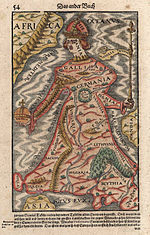
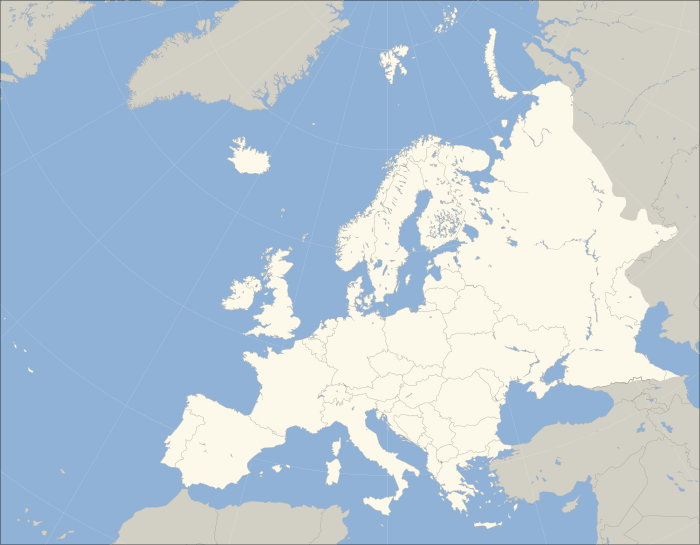
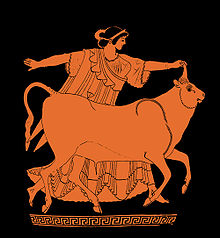







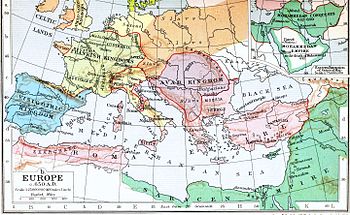
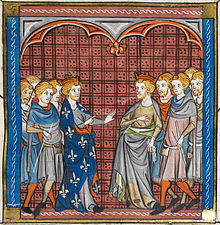



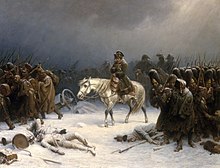
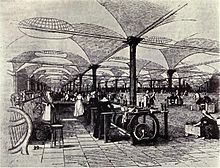
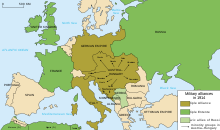


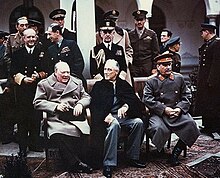
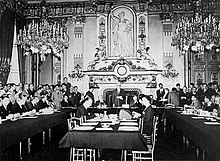












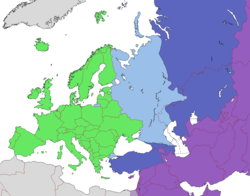
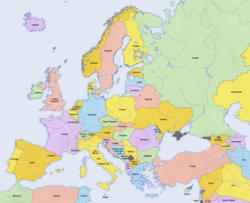

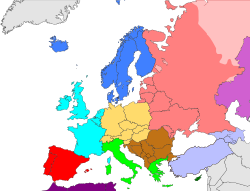


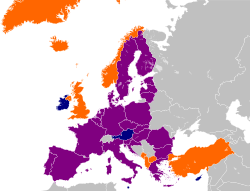



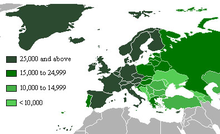







No comments:
Post a Comment
Jayant Parkash Is Welcome All world to my blog